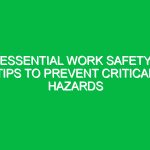Introduction
Hello team, and thank you all for gathering today for this important Toolbox Talk. Today, we are diving into a critical topic that affects each of us—injuries in the workplace and the staggering statistic of One Billion Dollars Spent on Injuries a Week. Understanding this figure is crucial for fostering a safe and productive work Environment. By the end of this talk, we’ll explore practical strategies to minimize risks and promote a culture of Safety that not only protects our well-being but also contributes to the overall efficiency of our operations.
Understanding the Cost of Workplace Injuries
First, let’s break down what the statistic One Billion Dollars Spent on Injuries a Week really means. This figure represents the financial burden that workplace injuries impose on businesses, employees, and the economy as a whole. This cost includes medical expenses, legal fees, lost productivity, and workers’ compensation claims. To put it into perspective, if we consider this on an annual basis, that’s over fifty-two billion dollars every year!
The Impact of Injuries
When we think about injuries, it’s not just about the dollar amount; it’s about the human cost. Every injury can lead to pain, suffering, and, in some cases, permanent disabilities. Take a moment to think: how would a serious injury impact your life or the lives of your colleagues? These are real-life consequences that extend beyond the workplace.
Real-Life Example
Consider a hypothetical scenario: a team member slips on a wet floor because a caution sign was not placed. This slip could lead to a sprained ankle, requiring medical attention and time off work. The costs associated with this injury—medical bills, lost wages, and the impact on team morale—could quickly add up to thousands of dollars. If this happens repeatedly, the cumulative effect on our organization can be devastating.
Why Should We Care?
So, why should we care about the One Billion Dollars Spent on Injuries a Week? The answer is simple: preventing injuries saves lives and money. Each of you plays a vital role in ensuring not only your Safety but also the safety of your coworkers. By focusing on health, safety, and the environment (HSE), we can significantly reduce the risk of injuries and illnesses.
Key Aspects of Injury Prevention
- Awareness: Stay alert to your surroundings and recognize potential Hazards.
- Reporting: Immediately report any unsafe conditions or incidents to your supervisor.
- Training: Participate in all safety Training sessions and apply what you learn.
- Equipment: Use Personal Protective Equipment (PPE) correctly and consistently.
- Communication: Foster open communication about safety concerns and suggestions for improvement.
Identifying Potential Hazards
As part of our commitment to safety, it’s crucial that we identify potential hazards in our work environment. Hazards can be categorized into various types:
- Physical Hazards: These include wet floors, exposed wires, and equipment malfunctions.
- Chemical Hazards: Be aware of any harmful substances you may be working with.
- Ergonomic Hazards: Improper lifting techniques or repetitive motions can lead to musculoskeletal injuries.
- Psychosocial Hazards: Stress, harassment, and bullying can impact mental health and safety.
Preventative Measures
To combat these hazards, we need to implement preventative measures. Regular safety audits, risk assessments, and employee training sessions are essential components of our safety strategy. For example, if we know that slips and falls are a common injury in our industry, we can take proactive steps, such as improving floor traction and ensuring that spills are cleaned up promptly.
Best Practices for Safety
Let’s discuss some Best Practices that can help us reduce the likelihood of injuries:
- Regular Breaks: Take short breaks to prevent fatigue, which can lead to mistakes and accidents.
- Proper Lifting Techniques: Always bend your knees and keep your back straight when lifting heavy objects.
- Maintain a Clean Workspace: A tidy work area reduces the risk of trips and falls.
- Know Emergency Procedures: Familiarize yourself with evacuation routes and emergency contacts.
- Stay Hydrated: Drink plenty of water, especially in hot working conditions, to maintain focus and stamina.
Regulations and Standards
Compliance with health and safety Regulations is not just a legal obligation but a moral one as well. Regulations such as the Occupational Safety and Health Administration (OSHA) standards set forth guidelines that protect workers from potential hazards. By adhering to these standards, we not only ensure our safety but also avoid costly penalties and legal ramifications for our organization.
How Compliance Impacts Safety
When we comply with safety regulations, we create a safer work environment for everyone. This compliance can lead to a reduction in the number of injuries and illnesses, which subsequently decreases the financial burden associated with the One Billion Dollars Spent on Injuries a Week. Moreover, a strong safety record can enhance our company’s reputation, making it an attractive place for potential employees and clients.
Engaging in Open Dialogue
Now, I want to open the floor for discussion. Are there specific hazards you’ve noticed in your work area? What suggestions do you have for improving safety? Your insights are invaluable, and together we can create a safer workplace.
Encouraging Responsibility
Each of you is responsible for your safety and the safety of those around you. This means actively participating in safety initiatives, sharing your observations, and being willing to speak up when you see something unsafe. Remember, safety is a collective effort.
Conclusion
In conclusion, the statistic of One Billion Dollars Spent on Injuries a Week is more than just a number; it’s a call to action for all of us. By being proactive, engaging in open conversations about safety, and adhering to Best Practices, we can significantly reduce the risk of injuries in our workplace. Thank you for your attention and commitment to making our work environment safer. Let’s work together to ensure that we all return home healthy and unharmed every day.


